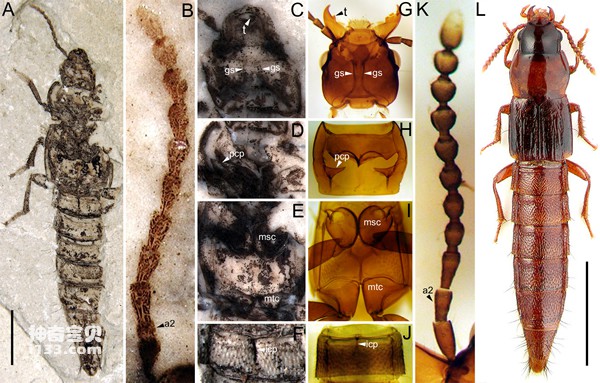According to the Nanjing Institute of Geology and Palaeontology, Chinese Academy of Sciences: Staphylinidae belongs to the insect class Coleoptera and is currently the most species-rich family on the earth. It is divided into 32 extant subfamilies and 1 extinct subfamily. It has been described At least 58,000 living species. Olisthaerinae is one of the smallest subfamilies of the family Olisthaerinae, containing only 2 living species and 1 fossil species. Jurassic cryptids are mostly reported in the Upper Jurassic strata in the Karatau area of Kazakhstan. There are only sporadic reports of cryptids from the Middle Jurassic in my country.

Morphological comparison of fossil Cryptoptera glabrata and its living representatives
Recently, two types of fish were discovered in the Middle Jurassic formation near Daohugou Village, Ningcheng County, Inner Mongolia and the Talbragar formation of the Upper Jurassic in Australia, by Dr. Cai Chenyang, Researcher Huang Diying and Dr. Robert Beattie of Australia from the Nanjing Institute of Geology and Paleontology, Chinese Academy of Sciences. Insects from the subfamily Glossopterinae. Through detailed comparative studies with Olisthaerus, the only extant genus of the subfamily Protolisthaerus, it was found that a new genus and species of Protolisthaerus jurassicus Cai et al., 2014; Jurassica from the Daohugou biota The morphological characteristics of Olisthaerus substriatus Paykull are very similar to those of living Olisthaerus substriatus Paykull (Figure 1), with only slight differences in elytra characteristics and body size. The living habits of extant glabrata are relatively unique. Both extant species live under the bark of coniferous trees.

Geographical distribution of C. glabrata in the Middle Jurassic
Based on morphological similarities, it is speculated that the Jurassic glabrata of the Middle Jurassic Daohugou fauna (about 165 million years ago) may have the same or similar living habits as the living type, that is, the Jurassic glabrata Winged insects may also live under the bark of coniferous trees. The large number of conifer fossils (such as Pityocladus and Yanliaoa) produced in the Daohugou area also provide strong evidence for this inference. The long-term morphological stagnancy of the morphologically stagnant evolution of C. glabrata may be attributed to the relatively small changes in its living environment and host plants. In addition, extant glabrata are only distributed in the northern temperate zone, including Northern Europe, Central Europe, Mongolia, and North America. However, the discovery of glabrata in the Talbragar fish layer in Australia has greatly expanded the distribution range of Cainopterinae ( figure 2). During the Jurassic period, the subfamily S. glabrata may have had a wider distribution range than it does today, and the two extant species of S. glabrata are relics.
animal tags:
We created this article in conjunction with AI technology, then made sure it was fact-checked and edited by a Animals Top editor.